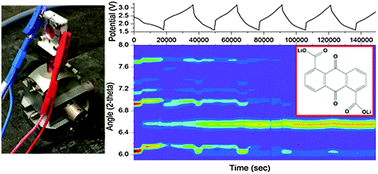Electrochemical lithiation-induced polymorphism of anthraquinone derivatives observed by operando X-ray diffraction†
Abstract
The use of organic molecules represents a very attractive and promising alternative for electrical energy storage applications. Quinones, in general, and anthraquinones, in particular, are especially attractive due to their ability to reversibly exchange multiple electrons per formula unit. When used as the active electrode material in a real lithium-ion battery (LIB), crystalline anthraquinone powders reversibly change crystal packing as a function of state-of-charge (redox state), with well-defined voltage plateaus appearing concomitantly with new phases. Operando powder X-ray diffraction (XRD) is a powerful method for screening the structural stability of organic cathode candidates and for understanding electrochemically-induced structural transformations within organic molecular crystals. Herein we explore the electrochemical lithiation-induced polymorphism of anthraquinone (AQ) and three related derivatives. We believe that this analysis can serve as a model for studying organic charge storage within crystalline small-molecule candidates.


 Please wait while we load your content...
Please wait while we load your content...